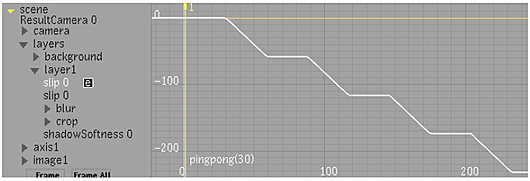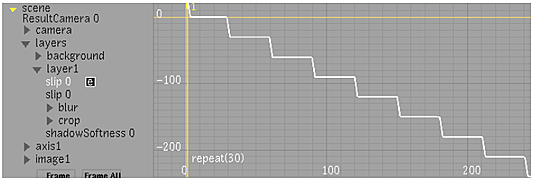Slip Functions
Use the following functions to slip the starting frame of a clip backwards or forwards using the slip channel. In effect, the displayed frame in a layer's clip will be the animation's current frame number plus the slip value. For example, a slip value of -15 holds the clip at the first frame and repeats it 15 times before the clip begins. In this way, you can create a freeze frame effect with one layer while animating another layer. A slip value of 10 begins the clip at frame 11. See Modifying Surfaces.
pingpong
Returns a slip value that makes a clip continuously cycle forwards and backwards. The result should usually be assigned to the slip channel of a layer.
| Syntax | pingpong(length) |
| Arguments | length is the number of frames to display before starting to play backwards. This is usually the length of the original clip. |
| Examples |
|
repeat
Returns a slip value that makes a clip continuously repeat forwards. The result should usually be assigned to the slip channel of a layer.
| Syntax | repeat(length) |
| Arguments | length is the number of frames to display before repeating from the beginning. This is usually the length of the original clip. |
| Examples |
|
repeatback
Returns a slip value that makes a clip continuously repeat backwards. The result should usually be assigned to the slip channel of a layer.
| Syntax | repeatback(length) |
| Arguments | length is the number of frames from the beginning to display backwards before repeating. This is usually the length of the original clip. |
| Examples |
|
frametoslip
Returns a slip value that makes a clip display at a given timebar frame. If the given frame number is constant, the resulting clips will freeze at that frame. The result should usually be assigned to the slip channel of a layer.
| Syntax | frametoslip(TimebarFrame) |
| Arguments | TimebarFrame is the timebar frame at which to display the clip. |
| Examples |
|




